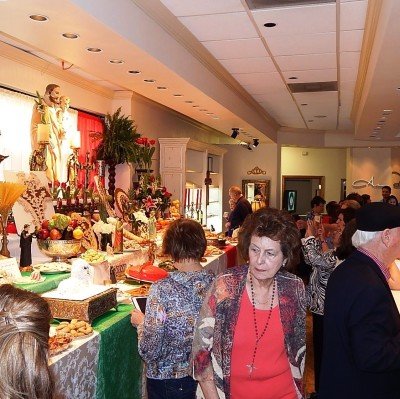Jewelry Store Catholic Tradition
This past weekend and Monday, March 19, Southern Catholics gathered to celebrate the feast day of Saint Joseph, aka San Giuseppe, the patron saint of fathers, workers, families and the Sicilian people, among others.
Sicilian immigrants first brought the custom of St. Joseph’s Altars to south Louisiana as a way to honor St. Joseph and ask for help or intercession. It began in the Middle Ages in Sicily during a drought which led to famine. The only crop that survived, and on which they depended for sustenance, was the fava bean, typically used to nourish animals.The people prayed to their patron saint for relief, and when their prayers were answered, it finally rained and crops were bountiful once again, they celebrated. To show thanks, they constructed altars adorned with food, and after paying homage to St. Joseph, the altar was broken down and the food distributed to the hungry and less fortunate.
Legend holds that a woman who steals a lemon from the altar will be blessed with fertility. I think I’ll wait a few years for lemon-thievery. The first altars were modest and simple, but today’s modern versions, both in church communities and private homes, are elaborate and decorative, mirroring the Italian spirit. Altars are constructed for various reasons, from making good on a promise, to giving thanks for a prayer answered, to requesting healing of a loved one, to being granted a happy life. Those who visit are invited to leave their petitions on the altar. This past weekend while visiting family, I paid a visit to a St. Joseph altar in Mandeville, about 30 miles North of New Orleans. I got to chat with Anne Dale, a native Louisianian of Italian descent, who hosts the altar in her jewelry shop with the help of friends and family. I ate homemade cookies (probably too many) and enjoyed a glass of wine (or two) with my plate of pasta, stuffed artichoke and fresh bread with about 50 others as we admired the beautiful altar on Saturday afternoon. When she was a young girl growing up in New Orleans, Anne’s aunt would take her to visit the St. Joseph altars in the French Quarter to say prayers and ask for St. Joseph’s help. Anne said her prayers, but also stared longingly at the beautiful spread on the altar. “I decided that when I got older,” Anne said, “I’d do an altar, too”. Anne has been transforming her shop into a beautiful St. Joseph altar for the past six years and each year welcomes about 300 visitors, who stop by to give thanks, offer petitions and share a meal in exchange for a small donation which is, in turn, given to a local food bank. Watch to see how Anne’s business is converted into the St. Joseph altar:
“Everything on the altar is symbolic,” Anne explains. “The three tiers of the altar depict the Holy Trinity, the cookies with almonds in the centers are representative of St. Lucy’s (the patron saint of the blind) eyes, and the bowl of breadcrumbs serve as St. Joseph, the carpenter’s, sawdust.” Every component of the altar has a purpose and is even blessed during a short prayer service presided over by a local priest. Upon entry, altar viewers receive a small bag of cookies with a prayer card and a lucky bean. St. Joseph altars are not confined to New Orleans. Several Catholic communities throughout Houston, like Christ the Redeemer in Cypress and St. Francis Xavier in South Houston, erected altars this year.
A tradition that has survived hundreds of years, the altar acts as a way to thank St. Joseph for deliverance from famine and as reminder to those who have been fortunate in life to share with those who have not. And with the amount of rain we’ve been getting lately, it seems like lots of people have been praying for Saint Joseph’s intercession.
Have you ever visited a St. Joseph altar? Do you have any favorite food-centric religious traditions? Let us know in the comments section.
from Houston Press by Ginny Braud March 21, 2012

